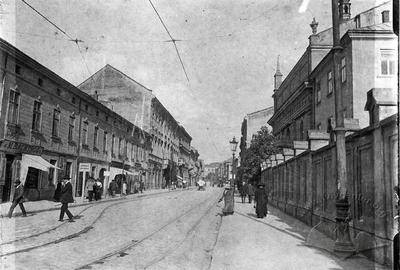Vul. Lychakivska, 005 – residential building
There are four buildings on this parcel, each of them having its history. The front house, a bright example of Historicism, was constructed by Ivan Levynskyi (Lewiński) in 1886-1889. Additions were designed by Władysław Derdacki and Stanisław Rewucki. The rear house, once owned by the cartographic and publishing factory Atlas, is adjacent to the city's eastern defensive line curtain. It is an architectural monument of local significance no. 619.
Architecture
The townhouse is located southeast of the historic center, in the former Halytske suburb. The four elongated rectangular in plan buildings are located on the perimeter of the plot. The main building dominates the street's linear housing and is notable for its architectural features.
The main house is built of brick in the Historicist style with Neo-Renaissance and Baroque elements. The building stands on stone foundations and has a high semibasement; it is plastered and covered with a gable tin roof. The semibasement and ground floors are decorated with squared and diamond rustication. The building is rectangular in plan and has two tracts and a gate located on the axis. The staircase of the main building is situated in the second tract to the right of the passage; it can be entered from the gate. The main façade had a centric axial composition, with two lateral protruded wall sections, accentuated at the second floor level by Baroque balconies supported by consoles and large seashells (replaced with tin ones in 2008). The wide window openings on the second and third floors of the protruded wall sections are decorated with portals. The façade's fourth floor is topped with a wide cornice on denticles. The gate is covered with a segmental vault leaning on arch walls, supported by pilasters; the spaces between the pilasters are decorated with semicircular arches in profiled archivolts with keystones. The stair flights are made of stone on three lower floors and of polished marble chips on the upper ones.
The narrow and long west and east wings are built of bricks on stone foundations without any pronounced style; they have three floors and smooth plastered walls with rectangular windows and doors and are covered with pent roofs (the rear one with a gable roof), each with two separate entrances. Some entrances to apartments in the wings are located on encircling galleries. Wooden 19th century staircases have different structures, with refined stylish railings. The semibasement premises in the west wing are covered with segmental and segmental lunette vaults.
Some authentic style elements in the façade design have been preserved till now: squared rustication of the semibasement tier, diamond and banded rustication of the ground floor, window trimmings and portals, interfenestral columns with capitals, consoles, as well as in the decoration of the gate (pilasters, profiled archivolts); metal cast and wooden chiselled elements of the wooden staircases and the main entrance wooden door have also survived.
The building is an illustrative example of the late 19th century Lviv architecture in the style of Historicism.
Personalities
August Schumann — owner of the
building floor before 1885
Władysław Derdacki — architect who
co-designed the superstructure of the 4th floor to the front building.
Edmund Köhler — architect who designed the buildings' reconstructions.
Ivan Levynskyi (Jan Lewiński) — architect who
designed the 3 floor Historicist building.
Joseph Ferenz — builder who
designed a reconstruction of the housing here.
Leon Bratkowski — owner of the
building parcel from 1885.
Leopold Karasiński — architect who designed the reconstruction of the rear building in 1934.
Stanisław Rewucki — architect who
co-designed the superstructure of the 4th floor to the front building.
Sources
- State Archive of Lviv Oblast (DALO) 2/2/224
- The 1849 cadastral map of Lviv
- Early 20th century photograph of the Lyczakowska street
- Мар'яна Долинська, Історична топографія Львова XIV–XIX ст. (Львів: НУ Львівська Політехніка, 2006)
Media Archive Materials
Related Pictures








